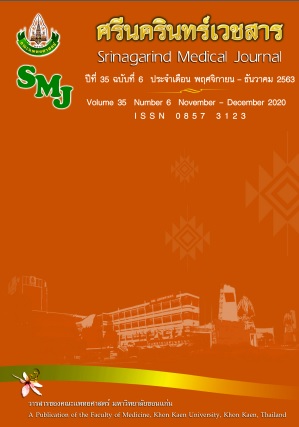ความแม่นยำของการตรวจวินิจฉัยมะเร็งต่อมลูกหมากด้วยเครื่องตรวจคลื่นสนามแม่เหล็กไฟฟ้าด้วยวิธีการหลายพารามิเตอร์
คำสำคัญ:
มะเร็งต่อมลูกหมาก; การตรวจด้วยเครื่องสะท้อนสนามแม่เหล็ก; ความแม่นยำในการวินิจฉัยบทคัดย่อ
วัตถุประสงค์: เพื่อศึกษาความแม่นยำของการตรวจวินิจฉัยมะเร็งต่อมลูกหมากด้วยเครื่องตรวจคลื่นสนามแม่เหล็กไฟฟ้าด้วยวิธีการหลายพารามิเตอร์
วิธีการศึกษา: เป็นการศึกษาย้อนหลังในผู้ป่วยที่ได้รับการตรวจด้วยเครื่องตรวจคลื่นสนามแม่เหล็กไฟฟ้า ร่วมกับการเจาะตรวจชิ้นเนื้อทางพยาธิวิทยาผ่านเครื่องตรวจคลื่นเสียงทางทวารหนัก ระหว่างเดือน กรกฎาคม 2555 ถึง สิงหาคม 2557 ภาพการตรวจด้วยคลื่นสนามแม่เหล็กไฟฟ้าประกอบด้วยหลายพารามิเตอร์ ได้แก่ ADC, DCE-MRI, Cho/cit ratio และ (Cho+creat)/cit ratio แล้วประเมินความแม่นยำในการตรวจวินิจฉัยโดยอาศัย AUC
ผลการศึกษา: การศึกษานี้ครอบคลุม 36 รอยโรคจากผู้ป่วย 28 ราย รอยโรคที่เป็นมะเร็งใน peripheral zone ให้ค่า ADC ต่ำกว่ารอยโรคที่ไม่ใช่มะเร็งอย่างมีนัยสำคัญ (p < 0.01) หากรอยโรคนั้นมีขนาดตั้งแต่ 1 ซม. ขึ้นไป จะให้ค่า (Cho+creat)/cit ratio สูงกว่าอEย่างมีนัยสำคัญ พารามิเตอร์ ADC มีความจำเพาะสูงถึงร้อยละ 87.5 ความแม่นยำร้อยละ 77.8 และ AUC 0.68 เช่นเดียวกันกับ พารามิเตอร์ DCE-MRI มีความจำเพาะสูงถึงร้อยละ 91.7 ความแม่นยำร้อยละ 83.3 และ AUC 0.78 พารามิเตอร์ Cho/cit ratio มีความจำเพาะสูงถึง ร้อยละ 91.7 แต่ความแม่นยำต่ำเพียงร้อยละ 54.2 เมื่อนำพารามิเตอร์ DCE-MRI มาร่วมกับ Cho/cit ratio จะให้ค่า AUC สูงที่สุดที่ 0.85 และมีความแม่นยำถึงร้อยละ 83.3 อย่างไรก็ตามการนำพารามิเตอร์ทั้งสามมาใช้ร่วมกัน กลับไม่ได้เพิ่มประสิทธิภาพอย่างมีนัยสำคัญ
สรุป: การตรวจด้วย DCE-MRI ร่วมกับ ADC มีความแม่นยำในการตรวจวินิจฉัยมะเร็งต่อมลูกหมาก สูงกว่าการตรวจด้วย MRS
เอกสารอ้างอิง
2. Barentsz JO, Richenberg J, Clements R, Choyke P, Verma S, Villeirs G, et al. ESUR prostate MR guidelines 2012. Eur Radiol 2012; 22(4): 746–757.
3. de Rooij M, Hamoen EHJ, Fütterer JJ, Barentsz JO, Rovers MM. Accuracy of multiparametric MRI for prostate cancer detection: a meta-analysis. AJR Am J Roentgenol 2014; 202(2): 343–351.
4. Reinsberg SA, Payne GS, Riches SF, Ashley S, Brewster JM, Morgan VA, et al. Combined use of diffusion-weighted MRI and 1H MR spectroscopy to increase accuracy in prostate cancer detection. AJR Am J Roentgenol 2007; 188(1): 91–98.
5. Riches SF, Payne GS, Morgan VA, Sandhu S, Fisher C, Germuska M, et al. MRI in the detection of prostate cancer: combined apparent diffusion coefficient, metabolite ratio, and vascular parameters. AJR Am J Roentgenol 2009; 193(6): 1583–1591.
6. Fütterer JJ. Multiparametric MRI in the Detection of Clinically Significant Prostate Cancer. Korean J Radiol. 2017; 18(4): 597–606.
7. Gao P, Shi C, Zhao L, Zhou Q, Luo L. Differential diagnosis of prostate cancer and noncancerous tissue in the peripheral zone and central gland using the quantitative parameters of DCE-MRI: A meta-analysis. Medicine (Baltimore). 2016; 95(52): e5715.
8. Liu X, Zhou L, Peng W, Wang C, Wang H. Differentiation of central gland prostate cancer from benign prostatic hyperplasia using monoexponential and biexponential diffusion-weighted imaging. Magn Reson Imaging 2013; 31(8): 1318–1324.
9. Woodfield CA, Tung GA, Grand DJ, Pezzullo JA, Machan JT, Renzulli JF. Diffusion-weighted MRI of peripheral zone prostate cancer: comparison of tumor apparent diffusion coefficient with Gleason score and percentage of tumor on core biopsy. AJR Am J Roentgenol 2010; 194(4): W316-322.
10. Verma S, Turkbey B, Muradyan N, Rajesh A, Cornud F, Haider MA, et al. Overview of dynamic contrast-enhanced MRI in prostate cancer diagnosis and management. AJR Am J Roentgenol 2012; 198(6): 1277–1288.
11. Casciani E, Polettini E, Bertini L, Emiliozzi P, Amini M, Pansadoro V, et al. Prostate cancer: evaluation with endorectal MR imaging and three-dimensional proton MR spectroscopic imaging. Radiol Med 2004; 108(5–6): 530–541.
12. Panebianco V, Sciarra A, Ciccariello M, Lisi D, Bernardo S, Cattarino S, et al. Role of magnetic resonance spectroscopic imaging ([1H]MRSI) and dynamic contrast-enhanced MRI (DCE-MRI) in identifying prostate cancer foci in patients with negative biopsy and high levels of prostate-specific antigen (PSA). Radiol Med 2010; 115(8): 1314–1329.
13. Hasumi M, Suzuki K, Oya N, Ito K, Kurokawa K, Fukabori Y, et al. MR spectroscopy as a reliable diagnostic tool for localization of prostate cancer. Anticancer Res 2002; 22(2B): 1205–1208.
14. Bellomo G, Marcocci F, Bianchini D, Mezzenga E, D’Errico V, Menghi E, et al. MR Spectroscopy in Prostate Cancer: New Algorithms to Optimize Metabolite Quantification. PLoS ONE 2016; 11(11): e0165730.
15. Prostate imaging – Reporting and data system (PI-RADS) version 2.1 2019 American college of radiology. [ https://www.acr.org/-/media/ACR/Files/RADS/Pi-RADS/PIRADS-V2-1.pdf?la=en ]
16. Rezaeian A, Tahmasebi BMJ, Chegeni N, Sarkarian M, Hanafi MG, Akbarizadeh G. Signal intensity of high B-value diffusion-weighted imaging for the detection of prostate cancer. J Biomed Phys Eng 2019; 9(4): 453-458.




